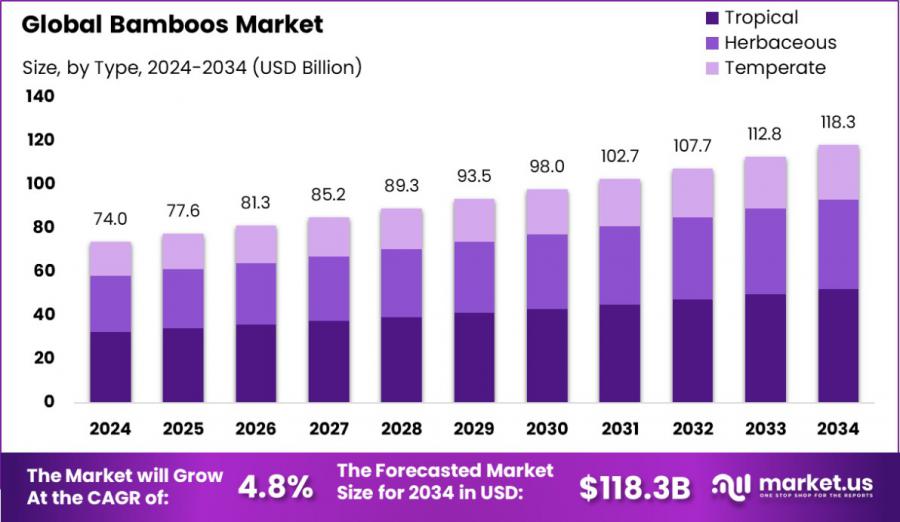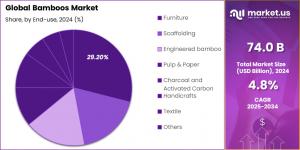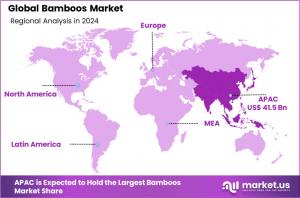
Bamboo Market to Reach USD 118.3 Billion by 2034, Growing at 4.8% CAGR
Bamboos Market size is expected to be worth around USD 118.3 bn by 2034, from USD 74.0 bn in 2024, CAGR of 4.8% during the forecast period 2025 to 2034
NEW YORK, NY, UNITED STATES, January 24, 2025 /EINPresswire.com/ -- Report Overview
Bamboo is a fast-growing, renewable plant belonging to the grass family Poaceae, known for its strong, lightweight, and versatile properties. It is widely used in construction, furniture, paper production, textiles, and even as a sustainable alternative to plastic. With over 1,400 species, bamboo thrives in diverse climates, from tropical to temperate regions, and has an impressive growth rate, with some species growing up to 35 inches per day. Its eco-friendly nature, carbon sequestration ability, and minimal cultivation requirements make it a key resource for sustainable industries.
The growth of the bamboo market is driven by its rapid maturity and adaptability to various climatic conditions. Unlike traditional hardwood trees, which take decades to mature, bamboo reaches full growth within 3–5 years, making it an ideal renewable resource. Favorable environmental policies promoting afforestation, along with advanced agricultural practices, have enhanced bamboo yield and quality. Additionally, technological advancements in processing techniques have expanded its application in diverse industries, fostering market expansion.
The rising demand for eco-friendly and biodegradable materials is significantly fueling the bamboo industry. As consumers and industries shift towards sustainable alternatives, bamboo products, including furniture, flooring, textiles, and packaging, are gaining traction. The increasing adoption of bamboo-based housing solutions, particularly in emerging economies, is further boosting demand. Additionally, its use in paper and pulp production, replacing conventional wood-based materials, is gaining prominence due to deforestation concerns.
The growing interest in sustainable architecture and green buildings presents lucrative opportunities for the bamboo market. Innovations in engineered bamboo for structural applications are creating new growth avenues. The rise of bamboo-based bioplastics and composites in packaging and automotive industries further enhances market potential. Additionally, government initiatives promoting afforestation and sustainable farming practices provide substantial support to bamboo cultivators and industries.
Several key factors drive the bamboo market, including environmental benefits, cost-effectiveness, and increasing consumer awareness of sustainability. Bamboo’s ability to absorb carbon dioxide efficiently and its minimal resource requirements make it a preferred choice for eco-conscious industries. Furthermore, its high strength-to-weight ratio, pest resistance, and durability make it a viable alternative to traditional materials. The expanding e-commerce sector and retail availability of bamboo products are also accelerating market growth.
Get a Sample PDF Report: https://market.us/report/bamboos-market/request-sample/
Key Takeaway
• Bamboos Market size is expected to be worth around USD 118.3 bn by 2034, from USD 74.0 bn in 2024, CAGR of 4.8% during the forecast period 2025 to 2034
• In 2024, The Tropical bamboo-segment held a dominant position in the bamboos market, capturing more than a 44.30% share.
• In 2024, The cultivation of bamboos using culms held a dominant position in the market, securing more than a 43.30% share.
• In 2024, drip irrigation held a dominant market position in the bamboos market, capturing more than a 48.40% share.
• In 2024, The furniture segment held a dominant market position in the bamboos market, capturing more than a 29.20% share.
• In 2024, The Asia Pacific (APAC) region dominated the global bamboos market, holding a substantial 56.20% share, valued at USD 41.5 billion.
Bamboos Market Segment Analysis
By Type Analysis
In 2024, the Tropical bamboos segment dominated the bamboos market, accounting for over 44.30% of the total share. This variety of bamboo flourishes in warm, equatorial regions, contributing significantly to its widespread cultivation. Known for its rapid growth and durability, tropical bamboo is highly sought after in industries such as construction, furniture manufacturing, and decorative applications due to its exceptional strength and visual appeal.
By Cultivation Method Analysis
The culm propagation method emerged as the leading cultivation technique in the bamboo market in 2024, securing a share exceeding 43.30%. This method involves planting sections of bamboo stems (culms), which then generate new shoots, making it one of the most efficient and reliable propagation techniques. Due to its ability to establish and grow faster than alternative methods, culm propagation is particularly preferred in commercial bamboo farming, where achieving high yields in a shorter time frame is crucial.
By Irrigation Method Analysis
In 2024, drip irrigation maintained a stronghold in the bamboos market, capturing over 48.40% of the share. This irrigation technique is widely adopted for its water efficiency and effectiveness in ensuring healthy bamboo growth. By delivering water directly to the plant’s base through a network of emitters, tubes, and valves, drip irrigation minimizes water wastage, evaporation, and runoff. It is especially advantageous in water-scarce regions, as it optimizes moisture retention, ensuring optimal conditions for bamboo cultivation.
By End-use Analysis
The furniture segment dominated the bamboo market in 2024, holding a market share of more than 29.20%. Bamboo's natural attributes—strength, flexibility, and aesthetic versatility—have positioned it as a preferred material in furniture production. From chairs and tables to decorative furnishings, bamboo is increasingly embraced by manufacturers seeking sustainable alternatives. The segment’s growth is further propelled by rising consumer demand for eco-friendly products, as bamboo is a renewable resource with a lower environmental impact compared to conventional wood furniture.
Buy Now: https://market.us/purchase-report/?report_id=38086
Key Market Segments
By Type
• Tropical
• Herbaceous
• Temperate
By Cultivation Method
• Culms
• Rhizomes
• Seeds
• Others
By Irrigation Method
• Drip Irrigation
• Flood Irrigation
• Rainwater Irrigation
By End-use
• Furniture
• Scaffolding
• Engineered bamboo
— Flooring
— Panels
— Beams
• Pulp & Paper
• Charcoal and Activated Carbon
• Handicrafts
• Textile
• Others
Top Emerging Trends
1. Rising Demand for Sustainable Materials: The growing awareness of sustainability and environmental conservation is driving the demand for bamboo-based products. Governments, businesses, and consumers are shifting toward eco-friendly alternatives, making bamboo a preferred choice over plastics, hardwoods, and synthetic materials. Its rapid growth, renewability, and biodegradability make it an excellent sustainable resource. From furniture and flooring to textiles and packaging, bamboo's diverse applications are expanding.
2. Expanding Use in Construction Sector: Bamboo is increasingly used in the construction industry due to its high strength, durability, and cost-effectiveness. It is widely used for making panels, flooring, scaffolding, and structural elements in residential and commercial buildings. Bamboo's ability to absorb carbon and withstand extreme weather conditions makes it a valuable resource for sustainable infrastructure. Several Asian and Latin American countries are promoting bamboo-based housing solutions.
3. Growth in Bamboo-Based Textiles: The textile industry is witnessing a surge in the use of bamboo fibers due to their softness, antibacterial properties, and moisture-wicking capabilities. Bamboo-based fabrics are gaining popularity in fashion, activewear, and home textiles. With consumers seeking sustainable clothing options, brands are launching bamboo-derived apparel as an alternative to synthetic fabrics. The increasing demand for breathable and eco-friendly materials in the fashion industry is expected to drive the expansion of bamboo textiles in global markets, especially in North America and Europe.
4. Increasing Applications in Paper Industry: Bamboo is becoming a preferred raw material for paper production due to its fast growth and high fiber content. With concerns over deforestation and the environmental impact of traditional wood-based paper, industries are shifting to bamboo-based alternatives. Governments and businesses are encouraging sustainable paper production by adopting bamboo pulp for packaging, printing, and tissue products.
5. Technological Advancements in Processing: Innovations in bamboo processing technologies are enhancing its efficiency, durability, and versatility. Advanced treatment methods are improving the quality of bamboo-based products, making them more resistant to pests, moisture, and degradation. New techniques in manufacturing engineered bamboo, such as laminated bamboo and bamboo composites, are expanding its applications in furniture, construction, and automotive industries.
Regulations on Bamboos Market
In 2023, India imported bamboo worth approximately $60.38 million, making it the world's largest bamboo importer. To enhance the bamboo sector, the government has implemented the Capital Investment Subsidy Scheme, requiring farmers and entrepreneurs to contribute 10% of the total project cost.
The Ministry of Agriculture & Farmers Welfare provides a subsidy covering 50% of the project cost in general states and 90% in North Eastern Region (NER) states, with the remaining 40% typically financed through bank loans.
Additionally, the National Bamboo Mission (NBM) has collaborated with the Government e-Marketplace (GeM) to launch a dedicated bamboo window on the GeM portal, promoting bamboo goods and services. These initiatives aim to streamline regulations and promote certification programs, thereby revitalizing the bamboo industry in India.
Regional Analysis
Asia-Pacific dominates the global bamboo market, accounting for 56.20% of the total share, with a market value of approximately USD 41.5 billion. The region’s dominance is attributed to the high availability of bamboo resources, favorable climatic conditions, and the widespread use of bamboo in construction, furniture, paper, and textile industries.
China, India, and Indonesia are the key contributors, with China being the largest producer and exporter. Government initiatives promoting sustainable bamboo cultivation and increasing investments in eco-friendly products further drive market growth in the region.
North America exhibits significant growth potential due to rising consumer preference for sustainable and biodegradable materials. The United States and Canada are witnessing increased adoption of bamboo-based flooring, furniture, and household products. The market benefits from growing awareness of bamboo’s environmental benefits and regulatory support for green building materials.
Europe is experiencing steady growth, with demand primarily driven by the construction, packaging, and textile industries. Countries like Germany, France, and the UK are at the forefront, leveraging bamboo’s sustainability aspects to meet stringent environmental regulations.
In Latin America and the Middle East & Africa, the market is gradually expanding, driven by increasing awareness, government support for afforestation programs, and growing applications in furniture, handicrafts, and industrial uses.
Key Players Analysis
◘ MOSO International B.V.
◘ Bamboo Australia
◘ Bamboo Village Company Limited
◘ Shanghai Tenbro Bamboo Textile Co., Ltd
◘ Simply Bamboo PTY LTD
◘ Xiamen HBD Industry & Trade Co., Ltd
◘ Dasso Group
◘ Smith & Fong Limited
◘ ANJI TIANZHEN BAMBOO FLOORING CO. LTD
◘ Fujian HeQiChang Bamboo Product Co., Ltd.
◘ BambroTex Inc.
◘ Cali Bamboo LLC
◘ Oceans Republic
◘ EcoPlanet Bamboo
◘ Kerala State Bamboo Corporation Ltd (KSBC)
◘ Other Key Players
Recent Developments
— In 2023, Xiamen HBD Industry & Trade Co., Ltd. specializes in bamboo kitchenware, operating a 30,000m² factory with 260 employees. In 2023, it completed 112 exports across four regions, partnering with Argo Brands LLC.
— In 2023, Cali Bamboo’s revenue ranges between $10M-$100M, with 100-500 employees (IncFact). It remains a key player in sustainable building materials, using bamboo’s renewability to offer durable, eco-friendly alternatives to traditional construction materials.
Strategic Initiatives
— Product Portfolio Expansion: Companies are investing in R&D to develop advanced formulations that meet regulatory and consumer demands.
— Geographic Expansion: Focus on high-growth regions like Asia-Pacific and the Middle East to capitalize on industrialization trends.
— Sustainability Initiatives: Efforts to align with global sustainability goals and minimize environmental
Lawrence John
Prudour
+91 91308 55334
Lawrence@prudour.com
Visit us on social media:
Facebook
LinkedIn
Distribution channels: Agriculture, Farming & Forestry Industry
Legal Disclaimer:
EIN Presswire provides this news content "as is" without warranty of any kind. We do not accept any responsibility or liability for the accuracy, content, images, videos, licenses, completeness, legality, or reliability of the information contained in this article. If you have any complaints or copyright issues related to this article, kindly contact the author above.
Submit your press release


